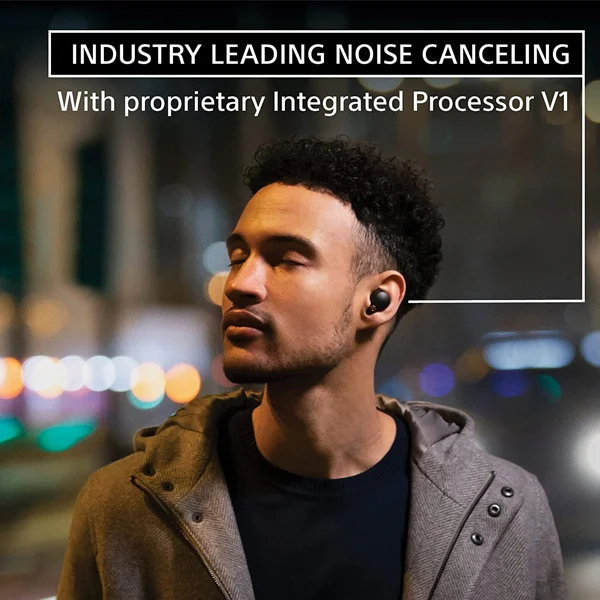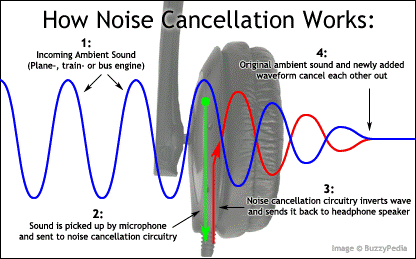Finding moments of peace and tranquillity in today’s hectic world can be difficult. That’s why it’s helpful to have Bluetooth earbuds equipped with noise-cancellation technology. These tiny technological marvels have completely changed the way we listen to music, podcasts, and audiobooks by allowing us to tune out the world around us. In this article, we’ll look at how noise-canceling technology in Bluetooth earbuds has changed over time, from its early days to the cutting-edge improvements that let us create our own peaceful soundscapes.
The Origins of Noise-Canceling Technology in Bluetooth Earbuds 🎧

The evolution of noise-canceling technology in Bluetooth earbuds has significantly transformed how we find moments of tranquility in today’s fast-paced world. Originally inspired by the aviation industry’s need to mitigate engine noise in the 1950s, noise-canceling technology emerged as a solution to reduce external distractions for pilots and passengers alike.
Initially, noise cancellation was implemented through large, heavy headphones primarily used in specialized fields like aviation and military communication. However, technological progress and the drive for miniaturization paved the way for noise-canceling earbuds that could be taken anywhere. This shift marked a turning point, allowing individuals to create their personal havens of sound in various environments such as planes, noisy offices, or commutes.
Read More:
- Exploring the Future of Sound with the Best ANC-Enabled Headphones
- Latest Gaming Headset for Elevating your Gaming Experience
🔮Miniaturization
The integration of digital signal processing revolutionized the form factor of headphones, transitioning them from bulky to sleek. Through the integration of miniature microphones within the earbuds, ambient sounds are skillfully captured and subsequently reversed into “anti-noise” waveforms by the internal processors.
This ingenious technique allows the resulting anti-noise waveforms to be channeled through the earbuds’ speakers, effectively countering and neutralizing external noise. As a result, users are bestowed with the luxury of undisturbed music appreciation, facilitating an uninterrupted auditory experience.
It was a huge step forward to incorporate ANC technology into earbuds. It was a convenient way for people to listen to music while blocking out background noise which was both portable and lightweight. People could now make their own personal sound oasis on a plane, in a noisy office, or on the way to work.
Digital signal processing has made it possible for headphones to go from being big and bulky to being small and sleek. Miniature microphones built into the earbuds started to pick up sounds from outside, while processors inside the earbuds analyzed and reversed these sounds to make an “anti-noise” waveform. When this anti-noise waveform was played through the earbuds’ speakers, it effectively blocked out outside noise, so users could listen to their music without any disturbances.
🎵Practical and Portable
This progression also enhanced the practicality and portability of noise-canceling technology. The days of lugging around large headphones or compromising audio quality for noise reduction were over. Noise-canceling earbuds, now compact and efficient, could easily fit into pockets and accompany users on their journeys, ensuring high-quality sound anywhere they went.
Furthermore, the integration of noise-canceling technology into Bluetooth earbuds expanded the range of possibilities for personalized and immersive audio experiences. This innovation allowed users to immerse themselves more deeply in their music, podcasts, games, or audiobooks, ultimately enhancing focus and engagement. The ability to tune out distractions while enjoying content elevated the overall listening encounter, making it not only more satisfying but also more captivating.
Read More: Noise Cancellation Earbuds For Games
As the noise cancellation (ANC) technology integrated into earbuds continued to advance, manufacturers started incorporating additional features. These features aimed to improve the overall user experience. Many models of noise-canceling earbuds now come equipped as standard with features such as voice assistants. They also include touch controls. These controls provide users with increased control over their listening experience. Additionally, noise-canceling earbuds offer seamless integration with smartphones. This integration provides users with convenience in managing their audio content and settings.
In conclusion, noise-canceling technology in Bluetooth earbuds has its roots in the 1950s aviation industry. The way we interact with sound has been fundamentally altered by the development of noise-cancellation technology. This technology has progressed from its early days of bulky headphones. Now, it has been incorporated into portable earbuds. Both Miniaturization and digital signal processing allow us to create tranquil soundscapes in a noisy world.
🔇Active Noise-Canceling: How It Works in Bluetooth Earbuds

Thanks to cutting-edge active noise cancellation (ANC) technology, noise-canceling earbuds can help you tune out the world around you and focus on your music. Let’s break down how this technology works, step by step:
Step 1: It takes in environmental noises.
The earbuds have built-in microphones that pick up sounds from the environment. These noises may include low-frequency sounds such as the hum of an engine, background chatter, or the rumble of a passing train.
Step 2: Evaluate Recorded Audio.
An embedded digital signal processor (DSP) analyses the recorded environmental noise in real-time. In addition, the digital signal processor evaluates the noise’s frequency, amplitude, and other factors to determine its nature.
Step 3: Make the noise-canceling waveform in Bluetooth Earbuds.
The DSP analyses the background noise and makes an “anti-noise” waveform that is the exact opposite of the waveforms of the sounds that were captured. If you play this waveform through your headphones’ speakers, it will dampen any outside noise.
Step 4: Add the waveform of noise-canceling technology to Bluetooth Earbuds.
The designers of the earbuds incorporate the generated anti-noise waveform into the audio signal. They seamlessly mix it with the user’s preferred audio content such as music or a podcast.
Step 5: Getting rid of background noise.
Interference occurs between the waveforms of the anti-noise wave and the waveform of the ambient noise when the two coincide. By causing destructive interference, the anti-noise waveform is able to effectively cancel out the background noise. This significantly reduces the amount of external noise reaching the user’s ears.
Step 6: User Experience with noise-canceling technology in Bluetooth Earbuds.
As background noise no longer disrupts the user’s audio content, they can now fully enjoy their listening experience. The noise-canceling earbuds make listening peaceful and immersive by blocking out sounds from the outside world.
It’s worth noting that active noise-canceling technology in Bluetooth earbuds is especially effective at reducing low-frequency sounds. These low-frequency sounds are often the most bothersome and difficult to block using passive isolation techniques alone.
Earbuds need sophisticated digital signal processing algorithms. These algorithms are used to process captured ambient sounds in real-time. Additionally, specialized hardware components are required. These components help generate the anti-noise waveform. These components create a noise-canceling experience that is accurate and efficient thanks to their seamless integration with one another.
By understanding how active noise-canceling technology works in Bluetooth earbuds, users can fully appreciate the engineering marvel. This marvel allows them to escape the chaos of the outside world. Moreover, it enables them to enjoy their favorite audio content with clarity and peace.
🔒Passive Isolation and Hybrid Approaches
Earbuds use passive isolation and hybrid methods in addition to active noise cancellation to improve listening. Let’s explore these concepts in more detail, step by step:
Step 1: Passive Isolation
Passive isolation also enhances the audio quality of your earbuds. Additionally, the physical design of the earbuds provides passive isolation. The earbuds are constructed to physically isolate the user’s ears from their surroundings. This barrier helps block and reduce the amount of sound that can enter the ear canal from the surrounding environment.
Step 2: Creating a Sound Barrier
The earbuds achieve passive isolation through various mechanisms, including creating a tight seal with ear tips that fit snugly in the ear canal and designing the earbuds themselves to physically obstruct the entry of sound waves.
The benefits of barriers go beyond simply enjoying your audio content. By reducing the external noise, you can listen to your preferred media at lower volume levels, promoting better hearing health in the long run. With less ambient noise seeping into your ears, you won’t need to increase the volume excessively to compensate, reducing the risk of potential damage to your hearing.
Step 3: Blocking External Sounds
Passive isolation reduces the amount of background noise transmitted to the user’s ears, including conversations, street noise, and any unwanted sounds present in the environment.
Step 4: Active noise-canceling and Passive Combination in Bluetooth earbuds
Numerous earbuds combine active noise-cancellation and passive isolation strategies in order to give users a more all-encompassing and immersive noise-canceling experience. Active noise cancellation analyses and cancels out background noise, while passive isolation creates a physical barrier to block other sounds from the outside.
Step 5: Maximizing Noise Reduction
These advancements use a hybrid approach. They collaborate to reduce unwanted noise across various frequencies.
his amalgamation strategically fuses active and passive methodologies to synergistically curtail external disturbances. Active noise cancellation excels at attenuating low-frequency sounds, while passive isolation casts a broader net of efficacy across various frequencies.
Step 6: Customizing Noise Reduction
Importantly, users who embrace hybrid methodologies frequently have the flexibility to finely adjust the level of noise suppression to align with their preferences and the surrounding environment. Moreover, the adaptability of noise-canceling earphones to the surrounding milieu empowers users to strike an equilibrium between personal isolation and situational awareness.
Combining active noise cancellation and passive isolation in earbuds creates an immersive experience for a wide range of users. This setup provides top-tier noise reduction and uninterrupted audio enjoyment. It remains effective irrespective of background noise.
🔊Advancements in Audio Quality
During the initial stages of noise-canceling earbuds, manufacturers often compromised audio quality to prioritize the device’s capacity for reducing ambient noise.
However, as a result of advances in technology, manufacturers have made significant progress toward improving sound fidelity without sacrificing noise-canceling capabilities. Premium earbud models have improved audio quality by incorporating high-quality drivers, cutting-edge audio codecs, and optimized equalization algorithms. These Upgrades in noise-canceling earbuds benefit music, work, and listening by preserving sound quality in quiet environments.
Beyond Noise Canceling Technology in Bluetooth Earbuds
Manufacturers have increased earbud functionality as noise-canceling technology in Bluetooth Earbuds has improved to meet the needs of a wider range of customers. Many models have touch controls, voice assistants, and mobile device integration. These smart features also enhance user convenience and control over their listening experience. These smart features make listening easier and give the user more control over what they hear. Furthermore, users can adjust a variety of noise-cancellation settings on some earbuds according to their preferences and operating conditions.
Conclusion
The introduction of noise-canceling earbuds has revolutionized the way we interact with sound. The development of noise-canceling earbuds began in the early aviation industry and has since expanded into the consumer market. These advanced earbuds offer a tranquil soundscape amid chaos. They feature enhanced noise-canceling, improved audio, and smart capabilities. Future Bluetooth earbuds will likely bring even clearer and more serene audio experiences.
Featured Image Credit: SDR-MJK



[…] What is Noise-Canceling Technology in Bluetooth Earbuds? […]
[…] order to help you focus on the game at hand, the earbuds are equipped with active noise cancellation (ANC). In a noisy or distracting gaming environment, ANC can be a huge […]
[…] Microphone: The noise cancellation feature on the microphone minimizes background noise, ensuring clear communication during […]
[…] Active noise cancellation is included on the Bose QC35 ii Game Headphone and can be adjusted to one of three levels.🎧🔇 […]
[…] headphones 🎧 offer advanced passive noise isolation 🔇, which means they can reduce external noise 🗣️ by creating a physical barrier 🚧 with […]